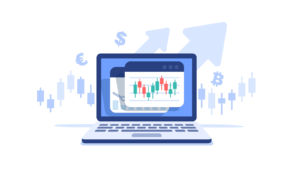Three trailblazing tech stocks stand at the forefront of the tech sector, wielding disruptive prowess to redefine industry norms. Their recent strides in multi-product adoption, customer-centric growth, and enterprise scalability are breeding market dominance.
The first one’s intricate integration within client frameworks, the second one’s relentless pursuit of customer acquisition and retention, and the third one’s expanding enterprise foothold unveil an intriguing tapestry of success stories shaping the tech terrain.
These companies aren’t merely delivering products but crafting ecosystems, fostering enduring partnerships, and reshaping conventional paradigms. As each entity charts its unique trajectory, the convergence lies in their dedication to nurturing long-term relationships, a common thread binding them towards industry leadership.
Read more to explore the intricate strategies, qualitative strengths, and qualitative milestones propelling these tech stocks toward the zenith.
Datadog (DDOG)

Platform adoption and multi-product usage are the key fundamental strengths of Datadog (NASDAQ:DDOG). For instance, in Q3 2023, Datadog witnessed a customer increase in multi-product usage. 82% of customers use two or more products (up from 80% year-over-year). Similarly, 46% of customers used four or more products (up from 40% year-over-year), while 21% used six or more products (up from 16%) compared to the previous year.
Fundamentally, customers’ escalating adoption of multiple products suggests Datadog’s platform’s effectiveness and versatility. Higher percentages of customers using multiple products suggest increased stickiness,’ signifying the integration of Datadog’s solutions deeply within clients’ operational frameworks. This robust adoption hints at a reduced risk of customer churn and establishing long-term relationships. This makes it one of those tech stocks to buy.
At the product portfolio level, the significant growth in multi-product usage implies that customers find value in combining various Datadog offerings. This indicates high satisfaction and reliance on Datadog’s suite for a comprehensive observability and monitoring solution.
On the other hand, Datadog achieved significant milestones in annual recurring revenue (ARR) across multiple product segments. Infrastructure monitoring ARR surpassed $1 billion; similarly, the Application Performance Monitoring Suite exceeded $500 million, while log management products surpassed $500 million in ARR.
Overall, Datadog’s substantial ARR demonstrates the company’s diverse revenue streams and the progressive scaling of multiple products. This diversification reduces reliance on a single product line and establishes Datadog as a multi-product platform. Therefore, these fundamentals indicate strong market acceptance and adoption of Datadog’s solutions, positioning the company as a leader within the industry.
HubSpot (HUBS)

HubSpot’s (NYSE:HUBS) ability to attract and retain customers is a crucial factor driving its growth. For instance, during Q3 2023, there was an addition of over 9.1K net new customers, reaching a total customer count exceeding 194K globally. This growth suggests the company’s appeal to businesses seeking effective CRM and marketing solutions. Also, the growth in average subscription revenue per customer signifies the company’s progress in increasing customer value over time.
Additionally, HubSpot’s ability to maintain gross retention in the high 80s underscores its focus on customer satisfaction and retention strategies. Fundamentally, HubSpot’s customer acquisition and retention leads are vital for long-term growth. The company’s ability to attract new customers while ensuring high retention rates contributes to a predictable revenue stream. Thus, the company’s focus on enhancing the customer experience and delivering value-added services may lead to maximizing customer lifetime value.
Moreover, the company has a diverse regional presence, with North America being the largest market, accounting for 70% of total revenue. Also, the planned acquisition of Clearbit (for approximately $150 million) highlights HubSpot’s strategic focus on bolstering its offerings, as the acquisition may boost external data enrichment capabilities. Hence, Clearbit’s vast data resources and capabilities align with HubSpot’s vision of providing customers with comprehensive and enriched data to improve personalized interactions. All in all, it’s one of those tech stocks to consider.
Finally, HubSpot’s guidance for Q4 and fiscal 2023 forecasts continued growth. For instance, total revenue is expected to grow by 19% year-over-year in Q4 and 24% year-over-year in 2023. Despite challenging macroeconomics, HubSpot’s management remains confident in its strategies and market opportunities.
Gitlab (GTLB)

GitLab (NASDAQ:GTLB) continually expands its customer base, which suggests the market acceptance of its DevSecOps platform. For instance, in Q3 fiscal 2024, the company had over 8,100 customers with an ARR of at least $5K (over 6,400 customers a year ago). The sustained customer increase demonstrates the scalability and adaptability of GitLab’s platform among enterprises.
Looking at the growth in high-value customers, there is a rise in those with an ARR over $100,000. A substantial 37% year-over-year growth, from 638 customers to 874, suggests GitLab’s lead in attracting and retaining larger enterprises. The growing base of high-value customers contributes significantly to GitLab’s revenue, proving GitLab’s competitiveness in the enterprise space.
Moving deep into net retention, GitLab’s consistently high dollar-based net retention rate was 128% in Q3. This reflects the company’s success in expanding revenue within its existing customer base. Thus, this metric underlines the platform’s value proposition and capability to upsell and cross-sell additional services and features to its customers over time.
Fundamentally, the robust net retention rate is indicative of customer satisfaction, underscoring the stickiness of GitLab’s platform. This indicates that customers find ongoing value in its services and are willing to invest more in the ecosystem.
Finally, all these metrics lead to significant growth in SaaS revenue, constituting over 25% of total revenue and growing by 53% year-over-year. This underscores its successful transition to an increasing demand for cloud-based solutions. Therefore, this adoption trend reflects the market’s preference for agile and scalable cloud offerings.
On the date of publication, Yiannis Zourmpanos did not hold (either directly or indirectly) any positions in the securities mentioned in this article. The opinions expressed in this article are those of the writer, subject to the InvestorPlace.com Publishing Guidelines.
